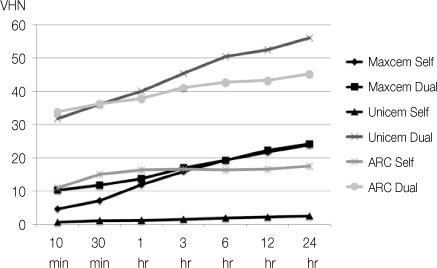Articles
- Page Path
- HOME > Restor Dent Endod > Volume 36(2); 2011 > Article
- Basic Research Effect of curing modes on micro-hardness of dual-cure resin cements
- Ki-Deok Lee, DDS, Se-Hee Park, DDS, PhD, Jin-Woo Kim, DDS, PhD, Kyung-Mo Cho, DDS, PhD
-
2011;36(2):-138.
DOI: https://doi.org/10.5395/JKACD.2011.36.2.132
Published online: March 31, 2011
Department of Conservative Dentistry, Gangneung-Wonju National University College of Dentistry, Gangneung, Korea.
- Correspondence to Kyung-Mo Cho, DDS, PhD. Professor, Department of Conservative Dentistry, Gangneung-Wonju National University College of Dentistry, 120 GangneungDaehangno, Gangneung, Gangwon, Korea 210-702. TEL, +82-33-640-3155; FAX, +82-33-640-3103; drbozon@gwnu.ac.kr
Copyright © 2011 Korean Academy of Conservative Dentistry
- 767 Views
- 9 Download
Abstract
-
Objectives The purpose of this study was to evaluate curing degree of three dual-cure resin cements with the elapsed time in self-cure and dual-cure mode by means of the repeated measure of micro-hardness.
-
Materials and Methods Two dual-cure self-adhesive resin cements studied were Maxcem Elite (Kerr), Rely-X Unicem (3M ESPE) and one conventional dual-cure resin cement was Rely-X ARC resin cement (3M ESPE). Twenty specimens for each cements were made in Teflon mould and divided equally by self-cure and dual-cure mode and left in dark, 36℃, 100% relative humidity conditional-micro-hardness was measured at 10 min, 30 min, 1 hr, 3 hr, 6 hr, 12 hr and 24 hr after baseline. The results of micro-hardness value were statistically analyzed using independent samples t-test and one-way ANOVA with multiple comparisons using Scheffe's test.
-
Results The micro-hardness values were increased with time in every test groups. Dual-cure mode obtained higher micro-hardness value than self-cure mode except after one hour of Maxcem. Self-cured Rely-X Unicem showed lowest value and dual-cured Rely-X Unicem showed highest value in every measuring time.
-
Conclusions Sufficient light curing to dual-cure resin cements should provided for achieve maximum curing.
- 1. Theodore M, Harald O, Edward J. Sturdevant's art & science of operative dentistry. 2006;5th ed. St. Louis, USA: Mosby; 225-227.
- 2. Mitchell CA, Abbariki M, Orr JF. The influence of luting cement on the probabilities of survival and modes of failure of cast full-coverage crowns. Dent Mater. 2000;16: 198-206.ArticlePubMed
- 3. Kwon PC, Park JW. Influence of thickness on the degree of cure of composite resin core material. J Korean Acad Conserv Dent. 2006;31: 352-358.Article
- 4. Kim YJ, Jin MU, Kim SK, Kwon TY, Kim YK. Polymerization of dual cured composites by different thickness. J Korean Acad Conserv Dent. 2008;33: 169-176.Article
- 5. Cadenaro M, Navarra CO, Antoniolli F, Mazzoni A, Di Lenarda R, Rueggeberg FA, Breschi L. The effect of curing mode on extent of polymerization and microhardness of dual-cured, self-adhesive resin cements. Am J Dent. 2010;23: 14-18.PubMed
- 6. Borges GA, Agarwal P, Miranzi BA, Platt JA, Valentino TA, dos Santos PH. Influence of different ceramics on resin cement Knoop Hardness Number. Oper Dent. 2008;33: 622-628.ArticlePubMedPDF
- 7. Shin HJ, Song CK, Park SH, Kim JW, Cho KM. Physical properties of different self-adhesive resin cements and their shear bond strength on lithium disillicate ceramic and dentin. J Korean Acad Conserv Dent. 2009;34: 184-191.Article
- 8. Danesh G, Davids H, Reinhardt KJ, Ott K, Schäfer E. Polymerisation characteristics of resin composites polymerised with different curing units. J Dent. 2004;32: 479-488.ArticlePubMed
- 9. Ferracane JL. Hygroscopic and hydrolytic effects in dental polymer networks. Dent Mater. 2006;22: 211-222.ArticlePubMed
- 10. Noronha Filho JD, Brandäo NL, Poskus LT, Guimaräes JG, Silva EM. A critical analysis of the degree of conversion of resin-based luting cements. J Appl Oral Sci. 2010;18: 442-446.ArticlePubMedPMC
- 11. Pedreira AP, Pegoraro LF, Góes MF, Pegoraro TA, Carvalho RM. Microhardness of reisn cements in the intraradicular environment: effect of water storage and softening treatment. Dent Mater. 2009;25: 868-876.PubMed
- 12. Vrochari AD, Eliades G, Hellwig E, Wrbas KT. Curing efficiency of four self-etching, self-adhesive resin cements. Dent Mater. 2009;25: 1104-1108.ArticlePubMed
- 13. Rueggeberg FA, Craig RG. Correlation of parameters used to estimate monomer conversion in light-cured composite. J Dent Res. 1988;67: 932-937.ArticlePubMedPDF
- 14. Ferracane JL. Correlation between hardness and degree of conversion during the setting reaction of unfilled dental restorative resins. Dent Mater. 1985;1: 11-14.ArticlePubMed
- 15. Mazzitelli C, Monticelli F, Osorio R, Casucci A, Toledano M, Ferrari M. Effect of simulated pulpal pressure on self-adhesive cements bonding to dentin. Dent Mater. 2008;24: 1156-1163.ArticlePubMed
- 16. Tezvergil-Mutluay A, Lassila LV, Vallittu PK. Degree of conversion of dual-cure luting resins light-polymerized through various materials. Acta Odontol Scand. 2007;65: 201-205.ArticlePubMed
- 17. Monteiro GQ, Souza FB, Pedrosa RF, Sales GC, Castro CM, Fraga SN, Galväo BH, Braz R. In vitro biological responsetoa self-adhesive resin cement under different curing strategies. J Biomed mater Res B Appl Biomater. 2010;92: 317-321.ArticlePubMed
- 18. Piwowarczyk A, Bender R, Ottl P, Lauer HC. Long-term bond between dual-polymerizing cementing agents and human hard dental tissue. Dent Mater. 2007;23: 211-217.ArticlePubMed
- 19. Aguiar TR, Di Francescantonio M, Ambrosano GMB, Gianini M. Effect of curing mode on bond strength of self-adhesive resin luting cements to dentin. J Biomed mater Res B Appl Biomater. 2010;93: 122-127.ArticlePubMed
- 20. Roberts HW, Leonard DL, Vandewalle KS, Cohen ME, Charlton DG. The effect of a translucent post on resin composite depth of cure. Dent Mater. 2004;20: 617-622.ArticlePubMed
REFERENCES
Tables & Figures
REFERENCES
Citations



Figure 1
Figure 2
Composition of materials used in this study
Micro-hardness value of test groups in each measurement times (VHN)
The number in the parentheses are the standard deviation.
VHN, Vicker's hardness number.
Different superscript letters mean statistical difference in each measured time.
Significances between self and dual curing of each resin cements (independent samples t-test)
The number in the parentheses are the standard deviation. VHN, Vicker's hardness number. Different superscript letters mean statistical difference in each measured time.

 KACD
KACD





 ePub Link
ePub Link Cite
Cite

